Section 1: Agency overview and resources
1.1 Strategic direction
The Commonwealth Grants Commission (the Commission) operates under the Commonwealth Grants Commission Act 1973. It is a statutory authority whose role is to provide advice to the Australian Government in response to terms of reference.
The main subject on which the advice is sought is the allocation among the states of the goods and services tax (GST) revenue. Terms of reference for these inquiries are decided by the Australian Government in consultation with the States. The reports are considered at the annual meeting of the Ministerial Council for Federal Financial Relations.
From time to time, the Commission is also asked to report on the finances of Australia's external territories, local government matters and the financing of services for Indigenous people. Terms of reference for those inquiries are developed by relevant Australian Government agencies and the reports are considered by their Ministers.
1.2 Agency resource statement
Table 1.1 shows the total resources from all sources. The table summarises how resources will be applied by outcome and by departmental classification.
Table 1.1: Commonwealth Grants Commission resource statement — Budget estimates
for 2011-12 as at Budget May 2011
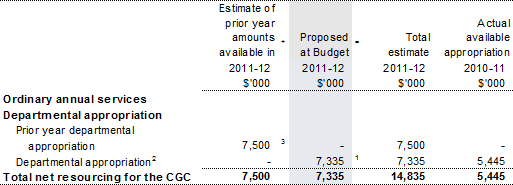
1. Appropriation Bill (No. 1) 2011-12. Note that $1 million appropriated in 2011-12 relates to 2010-11 outputs.
2. Includes $0.1 million in 2011-12 for the departmental capital budget (refer to Table 3.2.5 for further details).
3. Estimated adjusted balance carried from previous year for annual appropriations.
1.3 Budget measures
Budget measures relating to the Commission are detailed in Budget Paper No. 2, Budget Measures 2011-12 and are summarised below.
Table 1.2:-Commonwealth Grants Commission 2011-12 Budget Measures
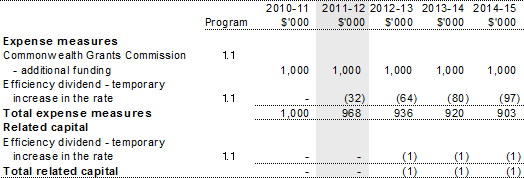
Prepared on a Government Finance Statistics (fiscal) basis.
Section 2: Outcomes and planned performance
2.1 Outcomes and performance information
Government outcomes are the intended results, impacts or consequences of actions by the Government on the Australian community. Commonwealth programs are the primary vehicle by which government agencies achieve the intended results of their outcome statements. Agencies are required to identify the programs which contribute to Government outcomes over the budget and forward years.
The Commission's outcome is described below specifying the strategy, program, objective, deliverables and key performance indicators used to assess and monitor the performance of the Commission.
Outcome 1: Informed Government decisions on fiscal equalisation between the States and Territories through advice and recommendations on the distribution of GST revenue and health care grants
Note: Recent terms of reference for the Commission have not required advice and recommendations on health care grants.
Outcome 1 strategy
The Commission's strategy is based on its role to provide advice to the Australian Government in response to terms of reference. Five-yearly reviews of the methods used to calculate the recommended State shares of GST revenue is the major activity associated with this outcome. The last five-year review was completed in February 2010. Between these reviews the shares are updated annually using the most recent data. The last update was completed in February 2011, as part of the review.
The Commission will continue with this strategy in the current budget year and the forward years.
Outcome expense statement
Table 2.1 provides an overview of the total expenses for Outcome 1.
Table 2.1: Budgeted expenses for Outcome 1
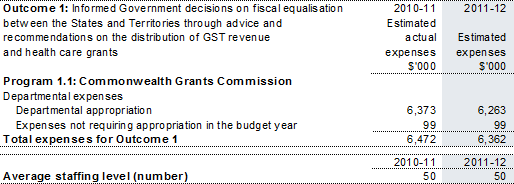
Contributions to Outcome 1
Program 1.1: Commonwealth Grants Commission
Program objective
The Commonwealth Grants Commission makes recommendations which are considered by government on the distribution of the GST pool.
Program expenses
There are no significant trends, changes or variances in the program expenses over the forward years.
Table 2.2: Program expenses

Program deliverables
Completion of the Report on State Revenue Sharing Relativities — 2012 Update for consideration by the Ministerial Council for Federal Financial Relations.
Program key performance indicators
The major effectiveness indicators are the quality of the Commission's research, the accuracy of its calculations and the acceptance of the results it presents to government.
Section 3: Explanatory tables and budgeted financial statements
Section 3 presents explanatory tables and budgeted financial statements which provide a comprehensive snapshot of agency finances for the 2011-12 budget year. It explains how budget plans are incorporated into the financial statements and provides further details of the reconciliation between appropriations and program expenses, movements in administered funds, special accounts and government Indigenous expenditure.
3.1 Explanatory tables
3.1.1 Movement of administered funds between years
The Commission does not have any administered funds.
3.1.2 Special accounts
Special accounts provide a means to set aside and record amounts used for specified purposes. Special accounts can be created by a Finance Minister's Determination under the Financial Management and Accountability Act 1997 or under separate enabling legislation. Table 3.1.2 shows the expected additions (receipts) and reductions (payments) for each account used by the Commission.
Table 3.1.2: Estimates of special account cash flows and balances
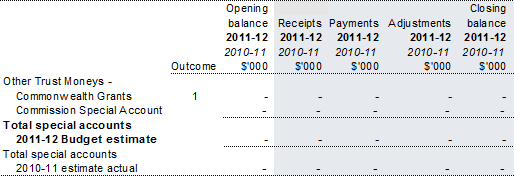
3.1.3 Australian Government Indigenous Expenditure
The Commission does not have any Australian Government Indigenous Expenditure.
3.2 Budgeted financial statements
3.2.1 Differences in agency resourcing and financial statements
There are no material differences between the resource information presented in the Budget Papers and Portfolio Budget Statements as a result of differences between Australian Accounting Standards and Government Finance Statistics.
3.2.2 Analysis of budgeted financial statements
The Commission normally receives a relatively steady level of funding and its workload and expenses vary over a five year cycle.
3.2.3 Budgeted financial statements tables
Table 3.2.1: Budgeted departmental comprehensive income statement
(for the period ended 30 June)
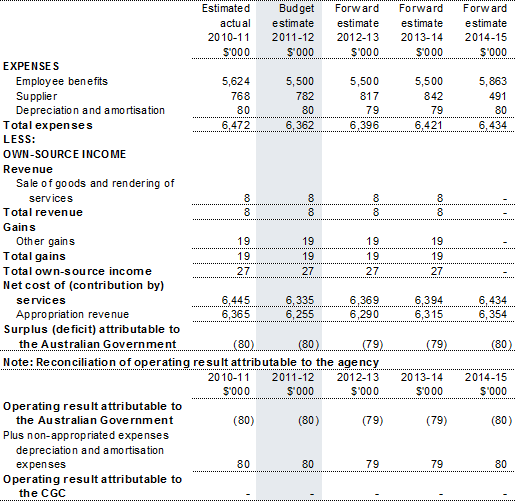
Prepared on Australian Accounting Standards basis.
Table 3.2.2: Budgeted departmental balance sheet
(as at 30 June)
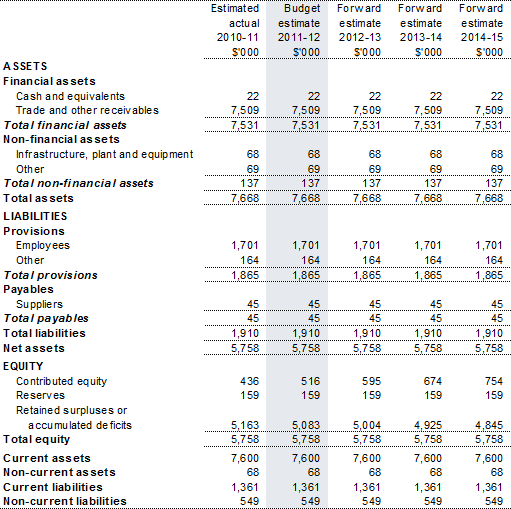
Prepared on Australian Accounting Standards basis.
Table 3.2.3: Budgeted departmental statement of cash flows
(for the period ended 30 June)
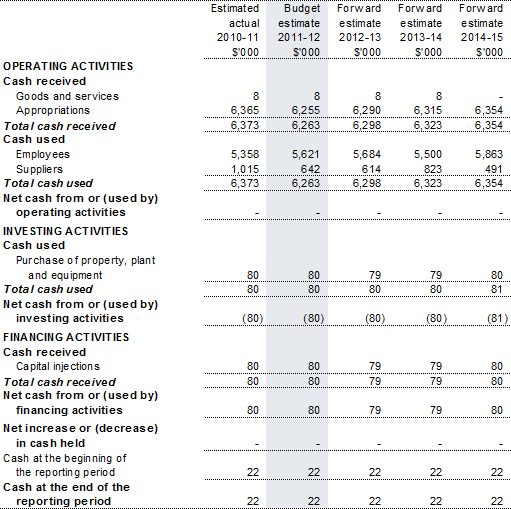
Prepared on Australian Accounting Standards basis.
Table 3.2.4: Departmental statement of changes in equity — summary of
movement (budget year 2011-12)
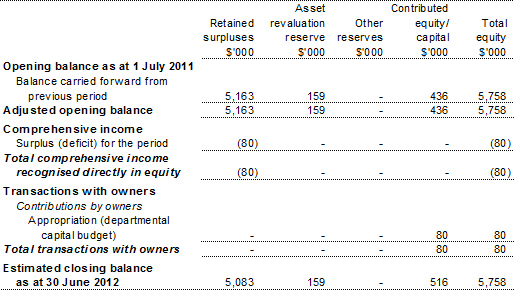
Prepared on Australian Accounting Standards basis.
Table 3.2.5: Departmental capital budget (DCB) statement
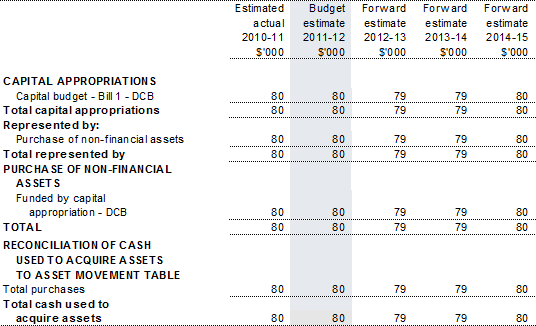
Prepared on Australian Accounting Standards basis.
Table 3.2.6: Statement of asset movements — departmental
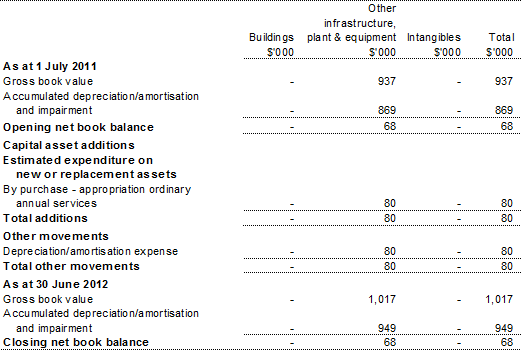
Prepared on Australian Accounting Standards basis.
3.2.4 Notes to the financial statements
The financial statements have been prepared on an Australian Accounting Standards basis.